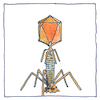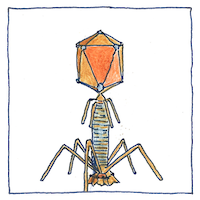Frederick Twort,
Félix d’Herelle
virology

|
Bacteriophage
Frederick Twort was interested in growing disease-causing bacteria in the lab so cures could be found for them. Bacteria causing leprosy and Johne’s disease were impossible to grow in standard lab cultures. Twort realized that for the leprosy bacillus to grow it needed something provided by the tubercle bacillus, which turned out to be vitamin K. Studying the smallpox virus, Twort found it was contaminated with staphylococcus bacteria and the staph bacteria were contaminated with another mysterious substance that Twort explained could be a stage in the life-cycle of bacterium, an enzyme produced by bacteria, or a virus that grew on and killed bacteria. * Two years later, Félix d’Herelle found “an invisible, antagonistic microbe of the dysentery bacillus,” and claimed it was “a virus parasitic on bacteria.” * D’Herelle called the newly found parasites bacteriophages. These have been used instead of antibiotics to combat diseases caused by bacteria.
Phage therapy
Phage therapy boomed in the twenties even though no one understood what bacteriophages were. Companies were quickly established and produced phage medicines with damaged phages, insufficiently concentrated phages, or phages targetting the wrong bacteria.
Space ships
In 1939, Helmut Ruska used an electron microscope to see what bacteriophages really are. They are, in fact, tiny spaceships, like lunar landers, with landing struts and a compartment at the top, designed to carry and inject a tiny payload of genetic material into a bacterium that is more than a thousand times bigger than they are like a small moon or asteroid on which they alight.



Phage therapy was largely replaced by antibiotics except in Russia and Georgia. Now that more is known about bacteriophages, and because phages are bacterium-specific and can penetrate defensive biofilms, there is more interest in phage and phage-enzyme therapies in the West.
See also in The book of science:
Readings in wikipedia: